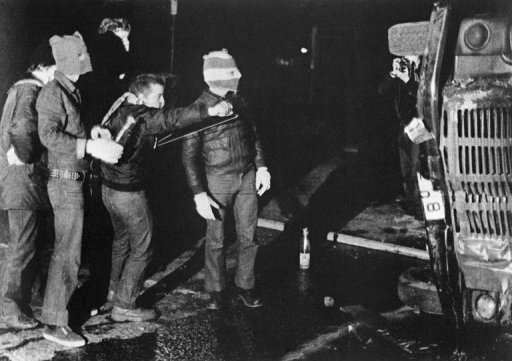Former prime minister Margaret Thatcher’s hardline approach to IRA hunger strikers and her staunch support of Unionism means few nationalists in Northern Ireland are mourning her death.
Thatcher presided over the province for more than a decade of strife, death and destruction as the “Troubles” raged.
The Irish Republican Army (IRA) tried to kill her with a huge bomb that ripped apart the hotel she was staying in for the 1984 Conservative Party conference in the English resort of Brighton.
She survived unscathed, but her death 29 years later prompted celebrations among some nationalists, who can never forgive her for her ‘the lady’s not for turning’ position as IRA member Bobby Sands and nine other young men starved themselves to death protesting for political prisoner status.
On the Falls Road in west Belfast, the neighbourhood most associated with Irish Catholic nationalism, a fresh piece of graffiti says: “Iron lady? Rust in hell.” Another says: “Maggie rot in hell”.
On the night after her death, some pubs on the street offered reduced price drinks to celebrate.
McVeigh was convicted twice for explosives offences and spent 16 years in prison.
McVeigh, now a Sinn Fein councillor in Belfast, said he became involved with the IRA as a result of the hunger strikes in the early 1980s.
Thatcher’s reaction to the death of Sands — she said “he chose to take his own life. It was a choice his organisation did not give to many of their victims” — incensed many republicans.
Although the Good Friday Agreement in 1998 bought relative peace to the conflict, which stretches back to the partition of the island in 1921, the legacy of the Troubles is still evident on the Falls Road in colourful wall murals immortalising the dead hunger strikers or celebrating past battles against British rule in Ireland.
It is also to be seen in the high railings around many buildings and the security cameras encased in steel mesh.
A year after the Brighton bombing, which killed five people, Thatcher signed the Anglo-Irish Agreement giving the Republic of Ireland a role in the governance of Northern Ireland for the first time.
The terms of the agreement said there would be no change to the status of Northern Ireland unless a majority of the people wanted it — seen by many as a precursor to the peace process of the 1990s.
Unionists rejected the accord as a betrayal and violence continued apace in Ireland, and the IRA launched fresh attacks on the British mainland.
Unionist politicians condemned the celebrations of Thatcher’s death. Jim Allister, a hardline Traditional Unionist Voice member of the Northern Ireland Assembly said they offered “an insight into the depravity of IRA supporters”.
Yet to the surprise of many, Sinn Fein’s Martin McGuinness, the province’s deputy first minister and the IRA’s chief of staff in the 1980s, also called for republicans to stop organising parties.
Sinn Fein party president Gerry Adams, whose voice had to be dubbed by an actor under laws brought in by Thatcher’s government in 1988 banning broadcasts from organisations believed to support terrorism, said simply that when people reflected on her, there will be people “who hate her and those who loathe her”.

COMMENTS
Please let us know if you're having issues with commenting.